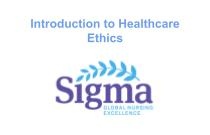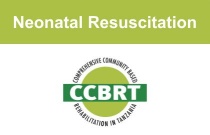Introduction to Healthcare Ethics
Francis Ward, Kim Mooney-Doyle, Debra Lynn Bastien
0.25 Hours
This course introduces learners to ways of classifying and organizing “levels” of ethics from the very abstract to the more practical (or from the practical to the abstract). Learners will be presented with a basic overview of meta ethics, normative ethics, and applied ethics, and learn how various theories and principles of eth....
Standard Operating Protocol for Management of SCD
Dr. Seun Odiase
This course covers the clinical presentation, laboratory investigations and clinical management of sickle cell disease at the primary care level. It also includes home care counseling which is also an essential aspect of preventing crisis events.
Tonsillitis Treatment Protocol
Nassifu Kyeyune
In this module you will learn about the common signs and symptoms of tonsillitis and the pathology behind it. You will also learn the causative agents and treatment modalities and when you need to refer to the next level of management. Finally you will be equipped with counseling and preventive measures you should give to patien....
Maternal Sepsis
United Nations Population Fund and LSTM
To understand the contribution of sepsis to maternal mortality To understand how to identify maternal sepsis To update knowledge and skills in the prevention of sepsis To update knowledge and skills in the management of sepsis
Pre-Eclampsia/Eclampsia
United Nations Population Fund and LSTM
To understand the contribution of eclampsia to maternal mortality To understand how to diagnose pre-eclampsia and eclampsia To update knowledge and skills in the prevention of eclampsia To update knowledge and skills in the treatment of pre-eclampsia and eclampsia
How to Conduct HIV Testing Services
Jhpiego in collaboration with Fred Hutchinson Cancer Research Center, Kenya Medical Research Institute (KEMRI), Jomo Kenyatta University of Agriculture and Technology (JKUAT), and the World Health Organization
The HIV Testing Services (HTS) Course offers guidance on how HTS should be conducted in different settings in Kenya, and has been adapted from the Kenya HTS Orientation Package (2021). This course is targeted towards healthcare workers providing HIV services, who have completed previous trainings on HIV prevention, care and trea....
Neonatal Resuscitation In Resource Limited Settings
Dr Antke Zuechner
This evidence-based neonatal resuscitation course for healthcare workers is a 1 day interactive course and introduces the concepts and basic skills on how to resuscitate a newborn baby at birth or in the first four weeks after. It is utilizing a blended learning approach that includes online introduction of basic knowledge and o....
The Advocating and Educating for Quality Improvement (A-EQUIP) Model
Clare Capito and Emma Wadey
The A-EQUIP framework is deployed by the Professional Midwife Advocate (PMA) and more recently by the Professional Nurse Advocate (PNA) roles. This elearning resource explores the A-EQUIP model from a conceptual and practical perspective, and also demonstrates how it can support a midwife or nurse in practice. There is an....
Sickle Cell Disease: Acute Management in Children and Adolescents
By The Hospital for Sick Children (SickKids) and Ghana College of Nurses and Midwives
This course is part of a series on Sickle Cell Diseases by the SickKids-Ghana Paediatric Nursing Education Partnership. The series was developed for healthcare workers (nurses, community health nurses, midwives, and physicians) in Ghana, but has broad relevance for healthcare workers in the region and globally. It is recommend....
In silico analysis of natural compounds targeting structural and nonstructural proteins of chikungunya virus
Jaspreet Jain,Anchala Kumari,Pallavi Somvanshi,Abhinav Grover,Somnath Pai,Sujatha Sunil
Chikungunya virus (CHIKV) is an alphavirus belonging to the Togaviridae family. Studies on antivirals for chikungunya generally target the replication machinery (nsP2 and nsP3 proteins). Alphavirus CP is a multifunctional protein known to act as serine protease for self-cleavage and viral genomic RNA binding. It is also known to....
Anaemia in solitary acyanotic ventricular septal defect in comorbid with pneumonia or pulmonary hypertension: A retrospective study of 75 paediatric cases
Geoffrey Joseph Changwe,Haizhou Zhang,Hongxin Li,Zeeshan Farhaj,Marlvin Anemey Tewara,Wenlong Zhang,Chengwei Zou
Anaemia is a common complication of a myriad medical conditions often met in general ward. Its etiology is complex and multifactorial, encompassing intrinsic and extrinsic factors. Nevertheless, the effect(s) of small to moderate VSD’s on the occurrence of both PNA and PH amongst paediatric patients, especially infants has not b....
Analysis of survival for patients in relation to central venous catheter and nosocomial blood stream infections: A case study of Aga Khan University Hospital, Nairobi
Francis Maina Kiroro,Majid Twahir
Central line associated bloodstream infection (CLABSI) is a type of infection that affects patients who utilize central venous catheter (CVC) during their hospitalization. CVC refers to any central venous access device inserted into the internal jugular, subclavian or femoral vein that terminates in the inferior vena cava or rig....
The occurrence of periodontal diseases and its correlation with different risk factors among a convenient sample of adult Egyptian population: a cross-sectional study
Marwa M.S. Abbass,Dina Rady,Israa Ahmed Radwan,Sara El Moshy,Nermeen AbuBakr,Mohamed Ramadan,Nermin Yussif,Ayoub Al-Jawaldeh
Periodontitis is defined as a chronic, progressive inflammatory disease affecting the periodontium surrounding the tooth. It eventually results in deterioration of the tooth-supporting apparatus and may result in tooth loss if untreated. Periodontal diseases, as well as dental caries, are considered the most widespread oral dise....
Biomimetic remineralization of acid etched enamel using agarose hydrogel model
Sara El Moshy,Marwa M.S. Abbass,Amal M. El-Motayam
Biomimetic remineralization is a non-invasive therapeutic approach that has received great attention in the last decades. It aims to restore the dental tissues to its normal biological function and estheticsn
Learnings from a COVID Positive Dialysis Unit: Staff & Patient Experiences
Glenda Rayment, Jeanny Gando RN and Dr. Tim Spicer
With the COVID outbreak impacting on the provision of dialysis services, the lessons learned from previous clusters can be used to implement strategies in the rapidly changing environment many nurses are currently faced with. The COVID 19 cluster stemming from the Crossroads Hotel in July 2020 presented south western Sydney wi....
Boosting diabetes and pre-diabetes detection in rural Ghana
Bernard Effah Nyarko,Rosemary Serwah Amoah,Alessandro Crimi
International Diabetes Federation. World Health Organization. Community-based health planning and services. body mass index. confirmed diabetic participants. unknown diabetic status participant. non communicable disease
Alcoholic bitters modulates sex hormones and some biochemical parameters of testicular function in male Wistar rats
Omowumi T. Kayode,Abolanle A.A. Kayode,Charles O. Nwonuma
Infertility describes prolonged difficulty at achieving success with conception between a male and female having unhindered access to sexual activity. A male’s inability to fertilize the female’s ovum for upwards of twelve months of unrestricted intercourse categorizes him as infertile. This challenge is represented globally acr....
Assessment of magnesium sulphate usage in pre-eclamptic and eclamptic women in Omdurman Maternity Hospital, 2017: A cross-sectional study
Bashir Alsiddig Yousef,Alaa Abdulmoniem Merghani,Walaa Salah Abdulla,Rasha Rifaat Binni
Preeclampsia/eclampsia is a pregnancy-specific disease with multisystem physiological disorder, which may lead to increased risk of maternal and perinatal mortality and morbidity. Magnesium sulphate (MgSO. In Sudan, preeclampsia/eclampsia is considered as one of the main factors leading to an increase in morbidity and mortality....
Haematology of N’Dama and West African Shorthorn cattle herds under natural Trypanosoma vivax challenge in Ghana
Ebenezer Yaw Ganyo,Johnson N Boampong,Daniel K Masiga,Jandouwe Villinger,Paa Kobina Turkson
Animal trypanosomosis, caused by trypanosomes mainly transmitted by tsetse flies results in annual economic losses in Africa in the range of US$ 1.0 - 1.2 billion in cattle production alone, and more than US$ 4.75 billion in terms of agricultural Gross Domestic Product (. The usual consequence of trypanosome infection is anaemia....
Platelet distribution width, mean platelet volume and haematological parameters in patients with uncomplicated plasmodium falciparum and P. vivax malaria
Elrazi A. Ali,Tajeldin M. Abdalla,Ishag Adam
In spite of the preventative measures, malaria remains a major public health concern. Malaria is responsible for 781,000 deaths in a year, the majority of which are in Sub -Saharan Africa. Previously, measurement of haematological blood parameters was unreliable due to intra and inter-method variation. Nowadays, automated analys....
Cost analysis of implementing HIV drug resistance testing in Kenya: a case study of a service delivery site at a tertiary level hospital in Kenya
Rachael W. Gachogo,Daniel N. Mwai,Frank G. Onyambu
Unprecedented increased access to antiretroviral therapy (ART) is one of the greatest milestones in the fight against the HIV epidemic, resulting in reduced mortality from AIDs-related causes and a global decline in HIV incidence (. ART is delivered through the public health approach in most low- and middle-income countries, whe....
Statin (3-hydroxy-3-methylglutaryl-coenzyme A reductase inhibitor)-based therapy for hepatitis C virus (HCV) infection-related diseases in the era of direct-acting antiviral agents
Sara Sobhy Kishta,Sobhy Ahmed Kishta,Reem El-Shenawy
Hepatitis C virus (HCV) infection is an important public health problem worldwide, as many HCV-infected patients develop liver cirrhosis and/or hepatocellular carcinoma (HCC). Recent improvements in the treatment of HCV infection have focused on the use of direct-acting antiviral agents (DAAs). Statins (inhibitors of 3-hydroxy-3....
Immunohistochemical expression of p53 in Type I and II epithelial ovarian cancer among Sudanese women: a cross-sectional study
Aisha Osman Mohamed,Nazik Elmalaika Husain,Rawia Eljaili Elmassry,Lubna Alnageeb,Mohammed Elhassan,Mohammed Siddig Abdelaziz
Ovarian cancer is a fatal disease, the mortality rate ranks the highest of all gynecological malignancies. Based on clinicopathological and molecular studies, epithelial ovarian cancer (EOC) is classified as type I or type II. Type I tumors are genetically quite stable, typically present at a low stage, and reveal distinct, morp....
Prevalence of neurogenic pulmonary edema among patients who died from head injury – a retrospective chart review
Erasmus E. Okello,Janat Tumukunde,Patience Atumanya,Sam Kalungi,Alex Muhindo,Arthur Kwizera
Neurogenic pulmonary edema (NPE) is an age-old clinical syndrome characterized by the acute onset of pulmonary edema following a significant central nervous system (CNS) insult. The exact mechanism is unknown as it is believed to be multi-pronged and data is sparse. The connection between CNS injury and hemodynamic dysfunction w....











